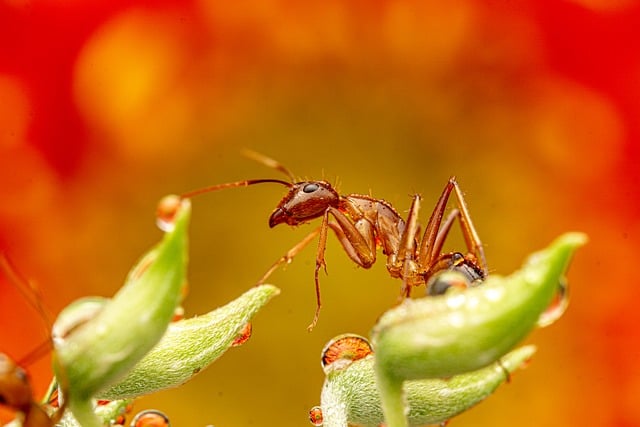Boxelder bugs (Boisea trivittatus), identified by their 1/4-inch size, flat bodies, and distinctive triangle heads, are a common household and commercial pest. They prefer warm habitats with shelter, laying eggs on host trees during spring and summer, leading to adult emergence in 4-6 months for sap feeding. Professional boxelder bug removal services employ eco-friendly solutions targeting all life cycle stages to ensure safe, effective control without harming the environment. These strategies include targeted insecticide applications for homes, specialized methods for larger spaces, regular inspections, maintenance, sealing entry points, and proper waste management in commercial settings. Popular eco-friendly solutions include neem oil and essential oils, with Integrated Pest Management (IPM) techniques focusing on least-toxic methods, prevention, sanitation, and biological controls. Monitoring programs also offer cost savings by reducing chemical interventions.
Understanding the boxelder bug life cycle is key to effective management and control. These pests, often found in residential and commercial spaces, go through a distinct series of stages—from eggs to adults—that impact their populations. This article guides you through identifying boxelder bugs and their habitats, delving into their lifecycle, exploring professional removal and extermination services, and highlighting eco-friendly solutions for minimal environmental impact. Learn how to navigate the complexities of boxelder bug control, from residential treatments to commercial removal, ensuring a pest-free environment with sustainable practices.
Identifying Boxelder Bugs and Their Habitats
Boxelder bugs (Boisea trivittatus) are a common pest found in many residential and commercial areas. Identifying these insects is the first step in managing their populations effectively. Adult boxelder bugs are approximately 1/4 inch long, flat, and have a distinctive triangular shape at their head. They range from reddish-brown to almost black in color, with three lighter bands running down their backs. Immature bugs, or nymphs, resemble adults but lack wings and are generally smaller.
These bugs thrive in habitats that offer both warm temperatures and shelter, making them common residents of tree branches, shrubs, and the sides of buildings. They prefer areas with ample sunlight exposure during the day and often congregate on south-facing walls. Identifying their preferred habitats is crucial when considering professional boxelder bug removal or eco-friendly solutions from boxelder bugs control services for residential or commercial spaces.
The Boxelder Bug Life Cycle: Eggs to Adults
The Boxelder Bug Life Cycle begins with eggs laid by adult females during the spring and summer months. These eggs are typically deposited on the bark of host trees, particularly boxelders, from which the bugs get their name. After a brief incubation period, usually around 10 days, the eggs hatch into nymphs. These nymphs undergo several molts as they grow, each stage increasing in size and developing more distinct features until they finally reach adulthood. This transformation can take anywhere from 4 to 6 months, depending on environmental conditions.
Adult boxelder bugs emerge ready to reproduce and can be found in large numbers feasting on the sap of host trees. They are particularly attracted to areas with dense tree populations and can quickly become a nuisance, causing damage to both residential and commercial properties. Professional boxelder bug removal services often employ eco-friendly solutions to manage these populations effectively. These methods include identifying and treating the specific life cycle stages, from egg to adult, to ensure complete control without harming beneficial insects or the environment.
Control and Management Strategies for Residential and Commercial Spaces
In both residential and commercial settings, managing Boxelder bugs effectively requires a multi-faceted approach. Professional boxelder bug removal services often employ a combination of strategies to control populations, ensuring a safe and eco-friendly environment. For homes, treatments may include targeted applications of insecticides around entry points, cracks, and crevices where these bugs congregate. Regular inspections and prompt response are key to preventing infestations from escalating.
Commercial spaces, due to their larger size and more complex structures, may necessitate specialized boxelder bug extermination methods. Professional services can offer eco-friendly solutions that target adult bugs, eggs, and nymphs while minimizing impact on non-target organisms and the environment. Regular maintenance, sealing entry points, and proper waste management are also integrated into comprehensive commercial boxelder bug removal plans.
Eco-Friendly Solutions: Minimizing Environmental Impact in Boxelder Bug Removal
When dealing with boxelder bugs, many homeowners and businesses opt for professional boxelder bug removal services to effectively manage infestations. While traditional extermination methods can be potent, eco-friendly boxelder bug solutions are gaining popularity for their minimal environmental impact. These methods include using natural repellents like neem oil or essential oils, which can deter the pests without harming beneficial insects or polluting water sources.
Residential and commercial boxelder bug treatment strategies often incorporate integrated pest management (IPM) techniques. IPM promotes the use of least-toxic methods first, focusing on prevention, sanitation, and biological controls like introducing natural predators. Some eco-friendly services also offer monitoring programs to track bug populations, ensuring that treatments are applied only when necessary. This not only reduces the need for chemical interventions but also saves costs for clients.
Understanding the intricate life cycle of boxelder bugs empowers both homeowners and professionals to implement effective control strategies. By identifying habitats, recognizing life stages from eggs to adults, and employing a combination of traditional and eco-friendly methods like professional boxelder bug removal and extermination services, it’s possible to manage populations in residential and commercial settings. Integrating these practices ensures a balanced approach to boxelder bugs control, minimizing environmental impact while achieving long-lasting results. For those seeking reliable solutions, professional boxelder bug treatment options offer peace of mind, providing safe and efficient management tailored to specific needs.
